
Resources
Tracks to two-way learning
Tracks to two-way learning is a train-the-trainer resource which aims to improve quality teaching and learning of Aboriginal students through the 4 dimensions of Staff Knowledge and Practice, Community Engagement, Policy and Practice, Learner Engagement.

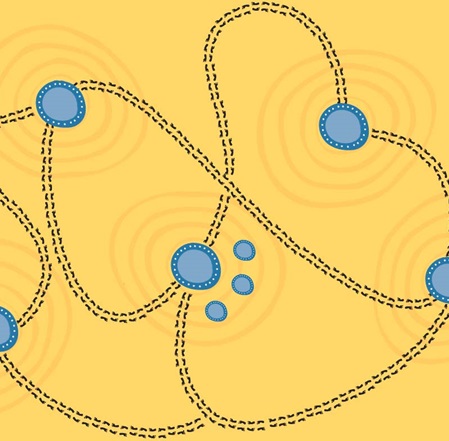
On this page
Facilitators Guide
The Facilitators Guide is for a Two-Way Facilitator Team, made up of an Aboriginal and non-Aboriginal person working as partners. The guide takes the team through how to use the resource and collaboratively plan and deliver professional learning using the 12 Focus Area resources and activities.
Facilitators guide
The Facilitators Guide provides guidance to a Two-Way Facilitator Team (an Aboriginal and a non-Aboriginal person working as partners in a team) on how to collaboratively plan and deliver short term and long term professional learning, using the 12 Focus Areas resources. Activities can be altered to ensure the delivery is most suited to the specific needs of a particular education or training site.
Focus Areas
The 12 Focus Areas are made up of background information, resources and activities the Two-Way Facilitator Team can use to improve their knowledge and deliver workshops. The activities can be tailored to the specific needs of a particular education or training site.
-1.tmb-resource.jpg?sfvrsn=ac5f471b_8)
Understanding language and dialect - Our dialects, our lives.
This Focus Area addresses situations in which there is a need to raise awareness of the existence of other dialects and of language variety in general, and Aboriginal English in particular. Although focusing mainly on Aboriginal English, the principles applied in this section are equally relevant to other dialect situations.
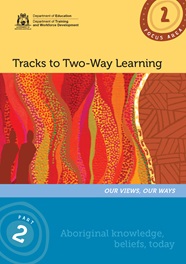
Our views, our ways - Aboriginal knowledge, beliefs, today.
The aim of this Focus Area is to raise the awareness of the structure and dynamics of Aboriginal families and communities. We also look at helping readers to improve their understanding of why some Aboriginal learners behave the way they do and to appreciate the pressures that impact on many Aboriginal learners, their families and members of the community.

The grammar of dialect difference - Difference, talking, hearing, understanding.
This Focus Area details ten points of grammar where Aboriginal English differs most from Standard Australian English (SAE) and provides resources for educators to understand these points and to teach SAE.

How we shape experience - Yarning, seeing, watching, doing.
Aboriginal English is often identified by the things most noticeable to people who don’t speak the dialect. These are generally the sounds and grammar. But what makes Aboriginal English most different from Standard Australian English (SAE) are the features of the dialect that are the least noticeable: the cultural conceptualisations.

How we represent our world - Art, symbols, gestures, opportunity. Manners, reading, knowledge, time limits.
This Focus Area is about whole texts. Whenever we listen to or create a text, we are influenced by our own experiences and ways in which we interpret or represent the world. Likewise, when we produce texts, these texts will be influenced by our own different experiences and interpretations of the world that belong to each of our cultures.
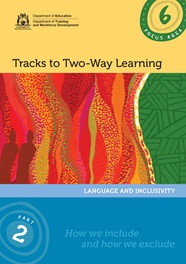
Language and inclusivity - How we include and how we exclude.
Focus Area 6 deals with how educational practices position Aboriginal learners by the way such practices represent Aboriginal people, their language and their culture.
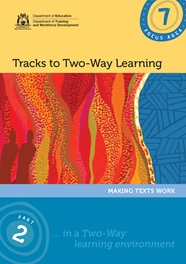
Making texts work...in a Two-Way learning environment.
The purpose of this Focus Area is to assist educators to assess texts to identify features that could exclude Aboriginal readers.
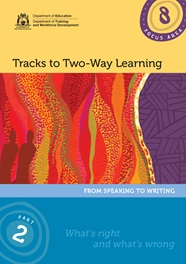
From speaking to writing - What's right and what's wrong.
This Focus Area may be difficult for some readers, as it focuses on the concept of correctness of Standard Australian English (SAE). Educators who have trained to become teachers (and English teachers in particular), may have been taught that their role is to teach SAE. Educators need to be reassured, therefore, that this is still their underlying purpose. However, the basic principle of education is understanding ‘where learners are at’ and moving them forward from there.

How we talk - How we talk, when we can talk.
In this Focus Area, we stand back from the actual form and structure of the languages or dialects we use and look at the bigger picture of language use. This is often called the ‘pragmatics’ of language. We look at the behaviours that go with our use of a particular language or dialect and have just as much significance as the actual words and structures. In fact, they are extremely important in communication.
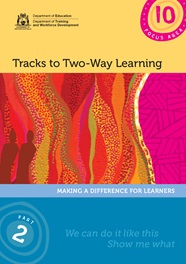
Making a difference for learners - We can do it like this. Show me what.
This Focus Area takes a broad view of different dialects and looks at the implications for education. It is recommended that it be used once a basic understanding or awareness of dialect difference has been achieved. Educators should then be in a better position to accommodate for dialectal difference at their education/training sites in terms of the curriculum provided and the pedagogy used to teach that curriculum.
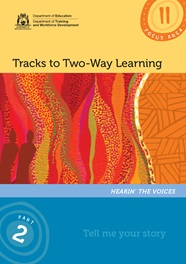
Hearin' the voices - Tell me your story (includes ten storybooks)
This Focus Area presents four stories, or ‘yarns’, written in Aboriginal English. These have been published in the form of booklets. Together with six other storybooks, they form part of this Focus Area. All ten Aboriginal English storybooks are provided in a separate folder as a part of the Tracks to Two-Way Learning package.

Toolkit for teaching - What we do with our mob.
Good teaching/learning programs don’t just happen. They must be planned carefully. Well-planned programs are necessarily flexible and responsive to the backgrounds and changing needs of learners. This is particularly important for learners who do not share the same language or world view as those who are comfortable with and fluent in Standard Australian English (SAE).
Sample Workshops
Facilitator teams can access the Sample Workshops Guide to help them plan and facilitate sample workshops on:
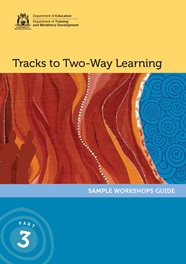
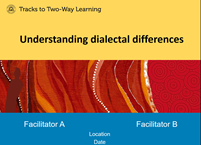
Understanding dialectal differences
The objectives of this workshop include understanding visible and invisible aspects of language and how they are linked.
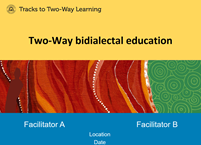
Two-way bidialectal education
The objectives of this workshop include understanding what Two-Way bidialectal education is and the importance of recognising and valuing the learner’s home language or dialect.
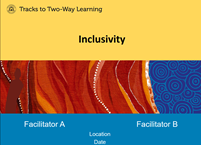
Inclusivity
At the end of this workshop, participants should know what inclusivity is and become aware of the elements of inclusive teaching and training practices and how to apply them.